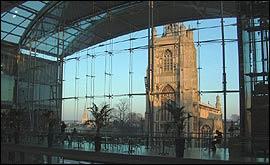"If interest in classical in waning, why then, when BBC Radio 3 offered Beethoven symphonies online a few months ago, did Beethoven draw an astonishing 1,369,893 downloads? How can we downgrade classical to esoteric when the Philadelphia Orchestra drew an estimated 8,000 listeners for its neighborhood concert at Montgomery County Community College in July? That's three times the capacity of Verizon Hall [in the Kimmel Center, Philadelphia]. What these two happy events have in common is a characteristic that's inconvenient for classical music presenters to consider: Both were free....
Given the escalation of ticket prices for orchestral concerts in the last few decades, plus the expanding number of entertainment options, the mystery in classical music is why times aren't even tougher than they are. Quite by accident a couple of months ago, I came across a routine Philadelphia Orchestra press release from Nov. 23, 1975, announcing a subscription program. Tickets were listed at $2, $3.50, $4, $4.50, $5, $7, $7.50, $8 - with the top ticket price a big $8.50. A complete listing for the season shows the highest ticket for a regular subscription concert was $10.50. Converted into 2005 dollars, that would mean the top ticket price to hear the Philadelphia Orchestra today should be $39.33. Of course, it's not. The highest ticket price next season will be $122 - an escalation three times the inflation rate."
Music Critic Peter Dobrin "Only Costs Can Stop the Music"
Philadelphia Inquirer September 4, 2005.
*
I guess that when I used to attend the Philadelphia Orchestra, at the old Academy of Music during college in 1972-75, I was paying about $1.50 for my upper balcony ticket. Today, an upper balcony ticket for the National Symphony Orchestra, at the Kennedy Center, costs from $20 to $44. The obstructed view, and behind the orchestra, $20 tickets sell out first. (A prime orchestra seat to the Opera in Lviv, Ukraine costs less than $10.)

Lviv, Ukraine Opera House (1895-1900, arch. Z. Gorgolewski). On the façade in the bays are situated allegorical figures by Popiel and T.Baracz: Comedy on the left, and Tragedy on the right. The bas-relief composition by A.Popiel "Joys and Suffering of Life" is in the three-cornered tympanium. The pediment is topped with copper statues by W. Wojtowicz. The theater, as generously decorated on the inside as on the outside, became the centerfold of the achievements of sculpture and painting of Western Europe at the end of XIX century, beginning of the XX century.




































